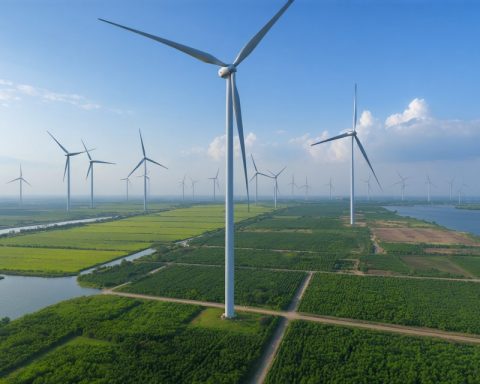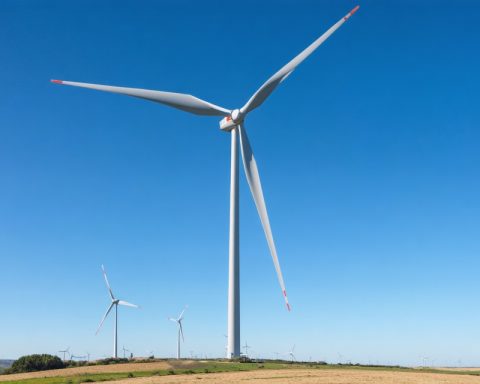- The U.S. EPA has released nearly $200 million, revitalizing green energy projects in Arkansas, previously stalled by funding freezes.
- The funds, part of the Biden administration’s Inflation Reduction Act 2022, aim to cut carbon emissions and enhance sustainable infrastructure.
- Central Arkansas’s Metroplan receives a $100 million grant for its Climate Pollution Reduction initiative, promoting green infrastructure development.
- Hope Enterprise Corporation secures over $93 million for its Solar for All program, assisting low-income families with solar panel installations to lower energy costs.
- Federal court rulings have allowed access to these funds, overcoming previous barriers posed by Trump administration policies.
- The EPA’s funding release underscores a commitment to climate action and a vision for a sustainable future in Arkansas.
Arkansas stands on the brink of a green transformation as the U.S. Environmental Protection Agency (EPA) releases nearly $200 million in previously frozen funds. This decision breathes new life into pivotal green energy projects that had been buried under uncertainty.
Envisioned under the Biden administration’s ambitious Inflation Reduction Act of 2022, these funds mark a decisive step towards reducing carbon emissions and boosting sustainable infrastructure. Among the beneficiaries, Metroplan and Hope Enterprise Corporation are positioned to ignite significant change across the state.
Central Arkansas’s Metroplan, once paralyzed by the Trump funding freeze, now harnesses a $100 million grant. This windfall fuels a Climate Pollution Reduction initiative aimed at deploying green infrastructure from the sprawling plains of Central Arkansas to the bustling streets of Northwest Arkansas and Fort Smith. The visionary plan promises not only to reduce pollution but also to cultivate economic growth in these regions.
Hope Enterprise Corporation stands ready with a solar-powered mission. Over $93 million will power their Solar for All program, targeting financial barriers faced by low-income families. By offering grants and loans to install solar panels, the initiative aspires to slash energy costs for these communities while contributing to a cleaner environment.
Last year’s edicts could have dimmed these bright aspirations, as President Trump’s executive orders froze funding pending federal review of climate-related expenditures. The tide turned, however, when judges in Rhode Island and Washington D.C. ruled in favor of accessing the funds, compelling the EPA to comply.
For now, optimism fills the air. Representatives from both Metroplan and Hope Enterprise Corporation confirm that the lifeline of funding is finally within reach. Despite political postures, like EPA Chief Lee Zeldin’s recent saber-rattling, the grants continue to flow, buoyed by federal mandates.
In unlocking these resources, the EPA not only recommits to climate action but signals hope for a greener, more sustainable Arkansas. Propel the momentum forward: invest in clean energy and make strides towards a thriving, environmentally conscious future.
Unlocking Arkansas’s Green Future: How Newly Released EPA Funds Spark A Sustainable Revolution
Introduction
Arkansas is poised for a significant shift towards sustainability following the U.S. Environmental Protection Agency’s (EPA) release of nearly $200 million in previously frozen funds. Initiated under President Biden’s Inflation Reduction Act of 2022, this financial windfall aims to facilitate green energy projects and advance sustainable infrastructure development in the state. Notable beneficiaries include Metroplan and Hope Enterprise Corporation, each leveraging these funds to reduce carbon emissions and stimulate economic growth.
Key Developments and Benefits
Metroplan’s Climate Pollution Reduction Initiative
Metroplan, a regional planning association serving parts of Central Arkansas, receives a substantial $100 million grant. This funding supports an overarching Climate Pollution Reduction initiative, which will:
1. Deploy Green Infrastructure: From urban settings like Northwest Arkansas and Fort Smith to rural expanses, the plan promises reduced pollution.
2. Drive Economic Growth: By investing in sustainable projects, Metroplan anticipates enhanced local economies through job creation and increased green investments.
3. Foster Community Engagement: Public-private partnerships and community involvement are expected to drive the program’s success and sustainability.
Solar for All by Hope Enterprise Corporation
Hope Enterprise Corporation’s “Solar for All” program, funded with over $93 million, aims to alleviate the financial burden of solar adoption among low-income families:
1. Level Financial Barriers: Provides grants and loans for solar panel installation, reducing long-term energy costs.
2. Promote Renewable Energy Use: Wider adoption of solar energy will significantly cut carbon emissions in the region.
3. Enhance Energy Independence: Communities increase resilience against traditional energy market fluctuations by relying on self-generated solar power.
Pressing Questions Answered
Why Were the Funds Frozen Initially?
The funds were frozen due to executive orders issued during the Trump administration, mandating a federal review of climate-related expenditures. This pause in funding delayed crucial environmental projects, now reactivated following legal interventions that compelled fund release.
What Are the Long-Term Impacts?
These projects are projected to have lasting impacts, including improved air quality, reduced reliance on fossil fuels, and enhanced economic prospects through green job creation and infrastructure investments.
Future Industry Trends and Market Forecasts
1. Expansion of Renewable Energy: Increasing investments in solar and other renewable sources are expected to drive state-wide and national market growth.
2. Technological Advancements: Innovations in energy efficiency and storage will play a key role in optimizing new infrastructure projects.
3. Policy and Regulation Evolution: As government policies increasingly favor renewable initiatives, further regulatory support is anticipated to sustain these trends.
Sustainable Solutions and Practical Recommendations
– For Individuals: Consider installing solar panels to harness renewable energy and reduce your carbon footprint. Check eligibility for local grants and loans offered by programs like Solar for All.
– For Businesses: Explore partnerships with regional green initiatives to enhance corporate social responsibility efforts and take advantage of potential tax benefits.
– For Communities: Engage in public forums and collaborate with local governments to actively shape and support infrastructure projects that align with sustainability goals.
Conclusion
With the EPA’s significant funding release, Arkansas can actively forge a greener future. By embracing new infrastructures and fostering community-led efforts, the state not only benefits environmentally but also economically. These initiatives underscore a broader national trend towards sustainability, offering practical benefits for all stakeholders involved.
For more information on the broader impact of such green initiatives, consider visiting the Environmental Protection Agency website.













